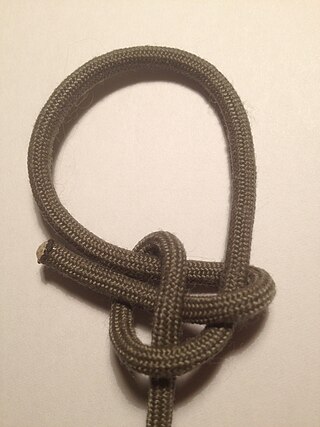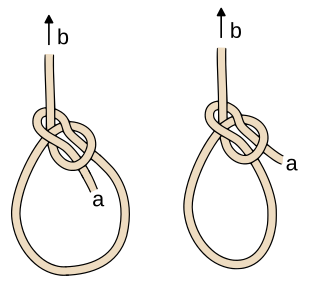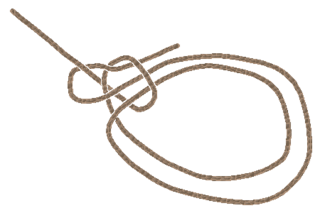
A knot is an intentional complication in cordage which may be practical or decorative, or both. Practical knots are classified by function, including hitches, bends, loop knots, and splices: a hitch fastens a rope to another object; a bend fastens two ends of a rope to each another; a loop knot is any knot creating a loop; and splice denotes any multi-strand knot, including bends and loops. A knot may also refer, in the strictest sense, to a stopper or knob at the end of a rope to keep that end from slipping through a grommet or eye. Knots have excited interest since ancient times for their practical uses, as well as their topological intricacy, studied in the area of mathematics known as knot theory.

The bowline is an ancient and simple knot used to form a fixed loop at the end of a rope. It has the virtues of being both easy to tie and untie; most notably, it is easy to untie after being subjected to a load. The bowline is sometimes referred to as king of the knots because of its importance. Along with the sheet bend and the clove hitch, the bowline is often considered one of the most essential knots.

A shank is a type of knot that is used to shorten a rope or take up slack, such as the sheepshank. The sheepshank knot is not stable. It will fall apart under too much load or too little load.

The Eskimo bowline, Cossack knot, reverse bowline, or 'anti-bowline' is in a class of knots known as 'eye knots' or 'loop knots'. The eye is formed in the end of the rope to permit attachments/connections. It is quite common in Russia and is often used instead of the bowline. In the simple bowline, the collar component forms around the 'standing part'. In contrast, the collar component of an Eskimo bowline forms around the outgoing eye-leg.

The water bowline is a type of knot designed for use in wet conditions where other knots may slip or jam.

A double bowline is a type of loop knot. Instead of the single turn of the regular bowline, the double bowline uses a round turn. This forms a more secure loop than a standard bowline.

A climbing harness is a piece of equipment that allows a climber to tie in to the safety of a rope. It is used in rock and ice climbing, abseiling, and lowering; this is in contrast to other activities requiring ropes for access or safety such as industrial rope work, construction, and rescue and recovery, which use safety harnesses instead.

The running bowline is a knot consisting of a bowline looped around its own standing end to create a noose.

The triple bowline knot is a variation of the bowline knot. The knot can be applied in emergency situations, such as mountain rescue.

The cowboy bowline or left-hand bowline, is a variation of the bowline loop knot.

The bowline on a bight is a knot which makes a pair of fixed-size loops in the middle of a rope. Its advantage is that it is reasonably easy to untie after being exposed to load. It is one of the two tie-in knots that are being taught by the German Alpine Club (DAV), generally being considered secure.

A Yosemite bowline is a loop knot often perceived as having better security than a bowline. If the knot is not dressed correctly, it can potentially collapse into a noose, however testing reveals this alternative configuration to be strong and safe as a climbing tie-in.

In knot tying, a bight is a curved section or slack part between the two ends of a rope, string, or yarn. A knot that can be tied using only the bight of a rope, without access to the ends, is described as in the bight. The term "bight" is also used in a more specific way when describing Turk's head knots, indicating how many repetitions of braiding are made in the circuit of a given knot.
The harness bend is a general purpose bend knot used to join two ropes together. The knot can be tied under tension and will not capsize.

The Portuguese bowline, also known as the Bowline on a coil, Caulker's bowline, or Lisbon surprise, is a variant of the bowline with two loops. The two loops are adjustable in size. Rope can be pulled from one loop into the other, even after tightening. Among other applications, the knot can be used as an equalising anchor, a litter bridle or a makeshift Bosun's chair. It is often regarded as one of the more important bowline variations.

The rigid double splayed loop in the bight is a knot that contains two parallel loops. Clifford Ashley wrote that it is "one of the firmest of the Double Loops since the two loops do not directly communicate with each other".. It is a variation of the alpine butterfly knot.

Karash double loop is a common name for a knot forming two loops. This knot has been a known variant of the Bowline on a bight per the International Guild of Knot Tyers, referred to as bowline twist or twisted collar bowline on a bight. The knot is also referred to as nœud de fusion in French references and sometimes called Fusion knot in English.

A bosun's chair is a device used to suspend a person from a rope to perform work aloft. Originally just a short plank or swath of heavy canvas, many modern bosun's chairs incorporate safety devices similar to those found in rock climbing harnesses such as safety clips and additional lines.

The Lapp knot is a type of bend. It has the same structure as the sheet bend, but the opposite ends are loaded. The slipped Lapp bend is also an exploding knot, which means that when pulling the quick release end it falls completely apart without further entanglement. It is as strong as or even stronger than the sheet bend, though much less common.




















